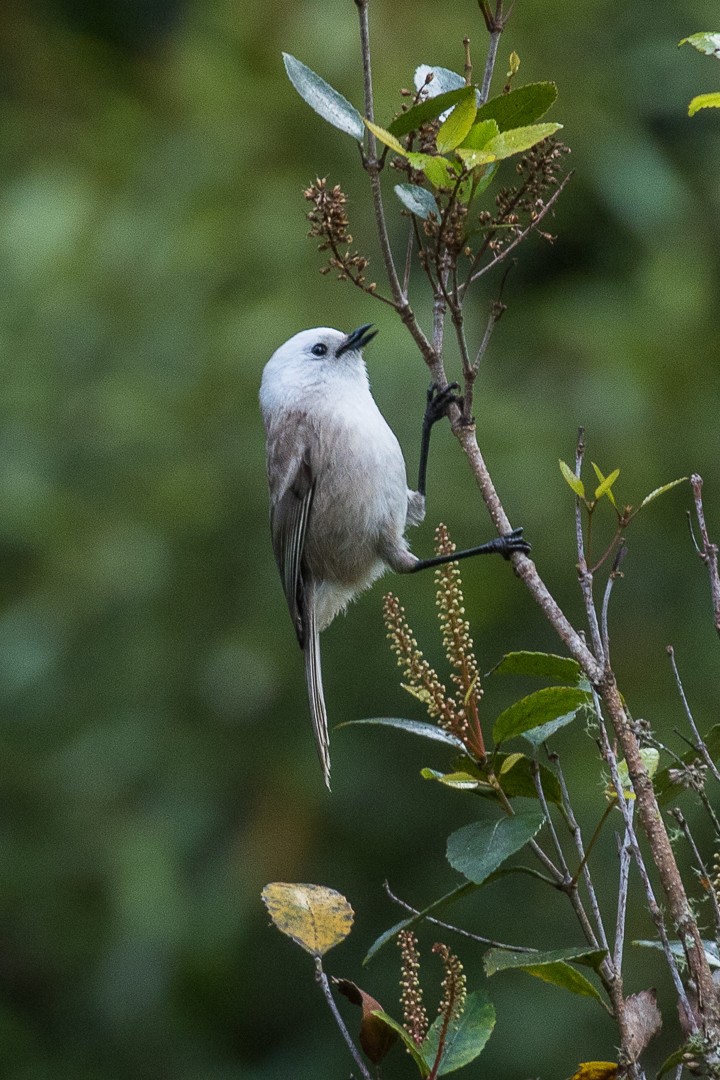Whitehead
A species of Mohoua, Also known as W H Scientific name : Mohoua albicilla Genus : Mohoua
Whitehead, A species of Mohoua
Also known as:
W H
Botanical name: Mohoua albicilla
Genus: Mohoua
Content
Description General Info
 Photo By Francesco Veronesi , used under CC-BY-SA-2.0 /Cropped and compressed from original
Photo By Francesco Veronesi , used under CC-BY-SA-2.0 /Cropped and compressed from original Description
The whitehead (Mohoua albicilla; Māori: pōpokotea) is a small species (15 cm in length, 18.5/14.5 g.) of passerine bird endemic to New Zealand. It is classified in the family Mohouidae. The male whitehead's upperparts, wings and tail are a pale brown in colour, while the head and underparts are white – in the case of the male an almost pure white in colour. Females and juveniles have similar colouration except that the nape and crown (top of the head) are shaded brown. The black beak and eyes contrast with the white head and the feet are bluish black in colouration. Formerly quite common and widespread in native forests in the North Island, the whitehead has suffered a marked decline in the past two centuries since European colonisation and today is restricted to a fraction of its former range. Historically, deforestation has destroyed large areas of habitat for this species but today the greatest threat is from predation by invasive mammalian species such as rats and stoats. It has been the subject of an active conservation campaign and has been successfully reintroduced into reserves near Auckland and Wellington respectively. In the past whiteheads held a special place in Māori culture. As well as the species appearing in many legends, whiteheads were viewed by Māori to have roles as messengers of the gods and as fortune tellers or seers – and because of these beliefs, live birds were caught and used in several different kinds of ceremonial rites. 
Size
15 cm
Life Expectancy
16 years
Nest Placement
Cavity
Feeding Habits
Whitehead's diet centers on insects like spiders, moths, and beetles, foraged from trees but not the ground. They occasionally eat native fruits, often feed while hanging upside down, and may join other species in mixed flocks for feeding.
Habitat
Whitehead primarily inhabits older tracts of native forest and scrub, found broadly across temperate regions. This species adapts well to diverse environments, including exotic conifer plantations and even occasionally ventures into gardens, farms, and orchards. Its breeding preference ranges from southern beech forests to manuka scrubs and can be located from coastal sites up to altitudes of 1300 meters. Geographic distribution is mainly isolated to temperate offshore and mainland areas within a specified oceanic nation.
Dite type
Insectivorous
General Info
Feeding Habits
Bird food type
Behavior
When encountered whiteheads often display flocking behaviour. The flocks generally consist of small family groups. 
Distribution Area
The range of this species has always been restricted to the North Island of New Zealand, as well as several offshore islands surrounding it, including Little Barrier Island (where it is the most common forest bird), Great Barrier Island and Kapiti Island; it has however, contracted markedly since the 19th century due to a number of human induced factors (see the Conservation section below). The distributions of the whitehead and its close relative, the yellowhead are allopatric, with the range of the yellowhead being restricted to the South Island. Whiteheads are generally restricted to the larger tracts of older scrub and native forest that remain in the North Island but have proven their adaptability by establishing populations in a number of exotic pine plantations, particularly on the North Island Volcanic Plateau. 
Species Status
Subfossil remains of whiteheads have been found on the North Island and the species was still very widespread when European settlement of New Zealand began in the 1840s. However, soon after, they began to decline as a result of both the widespread clearance of lowland forests for agriculture and the predation by several species of mammalian predators introduced by Europeans, including several species of rodents and mustelids. Such introduced species remain a problem for many whitehead populations today, as they both compete with them for food and prey upon the birds themselves. As a result, the species has experienced local extinctions of many of its populations throughout the North Island, particularly in its northern regions; whiteheads disappeared from Northland in the 1870s and from the greater Auckland area in the 1880s. They also disappeared from Great Barrier Island in the 1950s. In an effort to restore this species to its former range, a number of conservation reintroductions have been carried out in the last twenty years. All these reintroductions were carried out as part of wider efforts towards eco-restoration at each of the native forest sites concerned. Due to the northern North Island local extinctions, whiteheads were, until recently, extinct on the mainland of the North Island north of about Hamilton. However, this situation has been rectified by 3 of the above releases in the Hunua Ranges, Waitākere Ranges and on Tiritiri Matangi Island. The Karori and Tiritiri Matangi reintroductions were done independently while the Hunua reintroduction was an Auckland Regional Council initiative. The Auckland Regional Council also played a part in the Waitākere Ranges "Ark in the Park" project release – the project is a joint effort being a joint effort between this local government body and the NZ conservation not for profit NGO Forest and Bird. 
Scientific Classification
Phylum
Chordates Class
Birds Order
Perching birds Family
Australasian warblers Genus
Mohoua Species
Whitehead